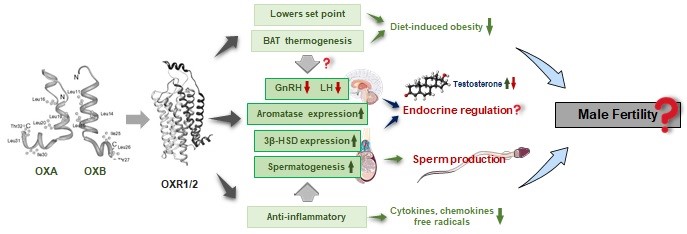
Orexins: the ‘multitasking’ neuropeptides in the energy metabolism and immune regulation of male reproduction
Abstract
Orexins are hypothalamus-derived neuropeptides with versatile functions. The most explored domains of orexins’ functions are their influence on the central nervous system (CNS) implicated in the regulation of sleep/wakefulness cycle, food intake behavior, energy homeostasis, and cognitive processes. Orexins reportedly bear two isoforms, orexin-A (OXA) and orexin-B (OXB), that act via their specific G protein-coupled receptor (GPCR), OX1R, and OX2R. These peptides also play vital roles in various other peripheral organs where they regulate metabolism, neuroendocrine functions, blood pressure, as well as reproductive functions. Interestingly orexins also exhibit immunoregulatory, anti-inflammatory properties and facilitate the mechanism of obesity resistance. Recent research has also shed light on the significant role of orexins, in particular orexin-A, in regulating reproductive functions in males since the Leydig cells, Sertoli cells, germ cells in various stages of the development, and even the epididymis and penis manifest the OXA receptor. It will be intriguing to explore the properties of the orexins in reversing obesity, downregulation of inflammatory responses, and mediation of male reproductive functions. The present article thus reviews these multitudinous properties of orexins and comprehends the possible connection among the behavioral, metabolic, anti-inflammatory functions of orexins with their roles in male reproduction.
Keywords
Full Text:
PDFISSN 2347–9825
Authors/visitors are advised to use Firefox browser for better experience of journal site.
Open Access: Researcher from developing/low economy countries can access the jorunal contents through WHO-HINARI .
 ISSN 2347-9825
ISSN 2347-9825

